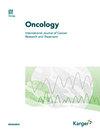A Scoping Review of Population Diversity in the Common Genomic Aberrations of Clear Cell Renal Cell Carcinoma.
IF 2.5
3区 医学
Q3 ONCOLOGY
引用次数: 0
Abstract
INTRODUCTION Previous literature has shown that clear cell renal cell carcinoma (ccRCC) is becoming a more prevalent diagnosis and that the incidence and mortality differ both regionally and racially. While the molecular profiles for ccRCC are studied regionally through biopsy and sequencing techniques, the genomic landscape and ccRCC diversity data are not well-studied. We conducted a review of the known genomic data on 6 of the most clinically relevant DNA biomarkers in ccRCC: Von Hippel-Landau (vHL), Polybromo-1 (PBRM1), Breast Cancer Gene 1-Associated Protein 1 (BAP1), Histone-Lysine N-Methyltransferase Domain-Containing 2 (SETD2), Mammalian Target of Rapamycin (mTOR), and Lysine-Specific Demethylase 5C (KDM5C). The review compiled genomic diversity data, incidence, and risk factor differences by geographical and racial cohorts. METHODS The review methodology was created using Preferred Reporting Items for Systematic Reviews and Meta-Analyses (PRISMA) principles from articles on PubMed and Embase through July 31, 2023, written and published in English, with diagnoses of primary or metastatic ccRCC via cytology or pathology, recorded the incidence of one or more of the 6 biomarkers, explored gene aberration via sequencing, were epidemiological in nature; and/or discussed basic science research, cohort studies, or retrospective studies. RESULTS Aberrations in vHL, PBRM1, and SETD2 driving ccRCC are studied frequently, but the data is heterogenous; whereas, there is a paucity in the data regarding KDM5C, PBRM1, and mTOR mutations. CONCLUSION Studying the genetic aberrations that frequently occur in different regions gives insight into what current research lacks. When more genomic landscape research arises, precision therapy, risk calculators, and artificial intelligence may help better prognosticate and individualize treatment for those at risk for ccRCC. Provided the scarcity of existing data, and the rising prevalence of ccRCC, more studies must be conducted at the clinical level.关于透明细胞肾细胞癌常见基因组畸变的群体多样性的范围研究。
简介:以往的文献表明,透明细胞肾细胞癌(ccRCC)正成为一种越来越普遍的诊断,其发病率和死亡率在地区和种族上都存在差异。虽然通过活组织检查和测序技术对ccRCC的分子特征进行了区域性研究,但对基因组状况和ccRCC多样性数据的研究还不够深入。我们对 6 种与临床最相关的 ccRCC DNA 生物标记物的已知基因组数据进行了回顾:Von Hippel-Landau (vHL)、Polybromo-1 (PBRM1)、Breast Cancer Gene 1-Associated Protein 1 (BAP1)、Histone-Lysine N-Methyltransferase Domain-Containing 2 (SETD2)、Mammalian Target of Rapamycin (mTOR) 和 Lysine-Specific Demethylase 5C (KDM5C)。综述汇编了基因组多样性数据、发病率以及不同地域和种族队列的风险因素差异。方法采用系统综述和荟萃分析首选报告项目(Preferred Reporting Items for Systematic Reviews and Meta-Analyses,PRISMA)原则,从PubMed和Embase上截至2023年7月31日用英文撰写和发表的文章中创建综述方法,这些文章通过细胞学或病理学诊断为原发性或转移性ccRCC,记录了6种生物标志物中一种或多种生物标志物的发病率,通过测序探讨了基因畸变,具有流行病学性质;和/或讨论了基础科学研究、队列研究或回顾性研究。结果对驱动ccRCC的vHL、PBRM1和SETD2基因畸变的研究较多,但数据不尽相同;而有关KDM5C、PBRM1和mTOR突变的数据则很少。当出现更多基因组图谱研究时,精准治疗、风险计算器和人工智能可能有助于更好地预测预后,并为ccRCC高危人群提供个体化治疗。鉴于现有数据的匮乏以及 ccRCC 发病率的上升,必须在临床层面开展更多的研究。
本文章由计算机程序翻译,如有差异,请以英文原文为准。
求助全文
约1分钟内获得全文
求助全文
来源期刊

Oncology
医学-肿瘤学
CiteScore
6.00
自引率
2.90%
发文量
76
审稿时长
6-12 weeks
期刊介绍:
Although laboratory and clinical cancer research need to be closely linked, observations at the basic level often remain removed from medical applications. This journal works to accelerate the translation of experimental results into the clinic, and back again into the laboratory for further investigation. The fundamental purpose of this effort is to advance clinically-relevant knowledge of cancer, and improve the outcome of prevention, diagnosis and treatment of malignant disease. The journal publishes significant clinical studies from cancer programs around the world, along with important translational laboratory findings, mini-reviews (invited and submitted) and in-depth discussions of evolving and controversial topics in the oncology arena. A unique feature of the journal is a new section which focuses on rapid peer-review and subsequent publication of short reports of phase 1 and phase 2 clinical cancer trials, with a goal of insuring that high-quality clinical cancer research quickly enters the public domain, regardless of the trial’s ultimate conclusions regarding efficacy or toxicity.
 求助内容:
求助内容: 应助结果提醒方式:
应助结果提醒方式:


